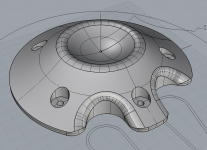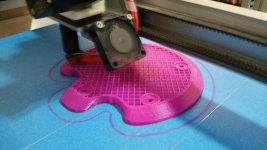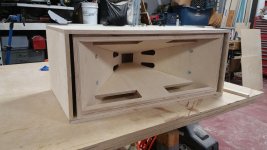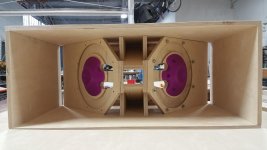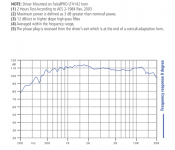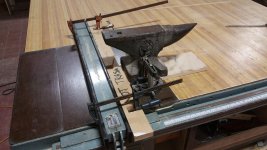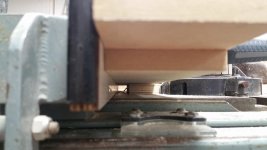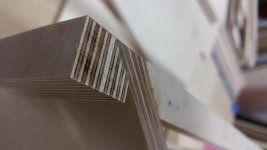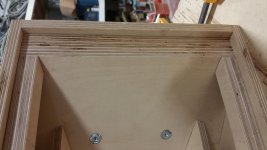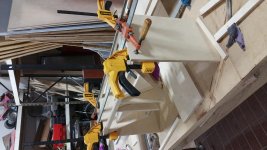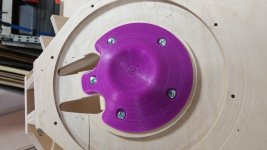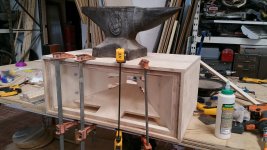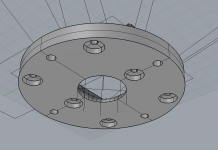I am printing a part that is 265cc and 12mm distance to xnull
Going to screw it in with some lath screws I had laying around so it can be removed (might try different ones to see what difference varying shapes / volumes have).
Going to screw it in with some lath screws I had laying around so it can be removed (might try different ones to see what difference varying shapes / volumes have).
Attachments
There could be a potential to eventually chew up the wood where the screws bite in. My furniture maker friend suggested to me to be gentle with he screws to avoid this. Of course nuts would help avoid that.
I did like your idea of having one central bolt and a tnut.
Some fun foam as a gasket may work well underneath to prevent vibration during testing.
I did like your idea of having one central bolt and a tnut.
Some fun foam as a gasket may work well underneath to prevent vibration during testing.
Last edited:
I used a single drywall Spax screw in the middle to clamp it down with a thin sheet of 1mm thick packaging foam sheet as a gasket to keep it from rattling or moving. Alternatively, 3 little dabs of hot melt glue with screw will keep it from rattling as well and is removable with a tug.
That is beautiful fit and finish. Truly a work of art. That tweeter aperture looks to be the perfect size for a 3.5in driver like a Scanspeak 10F/8424. Lower distortion and still 102dB with horn gain - a perfect match for dual 10CL65's. Plus you can cross over at 800Hz. Just a thought - even Weltersys has done this with a $10 TC9FD and agrees it sounds cleaner than a CD.
Here is what I was able to do with a little 2.5in SB65WBAC25-4.
http://www.diyaudio.com/forums/full...l-range-tractrix-synergy-122.html#post4554591
Here is HD plot of 10F in the Trynergy at 1m and 100dB (mostly 2nd order and 3rd is tiny):
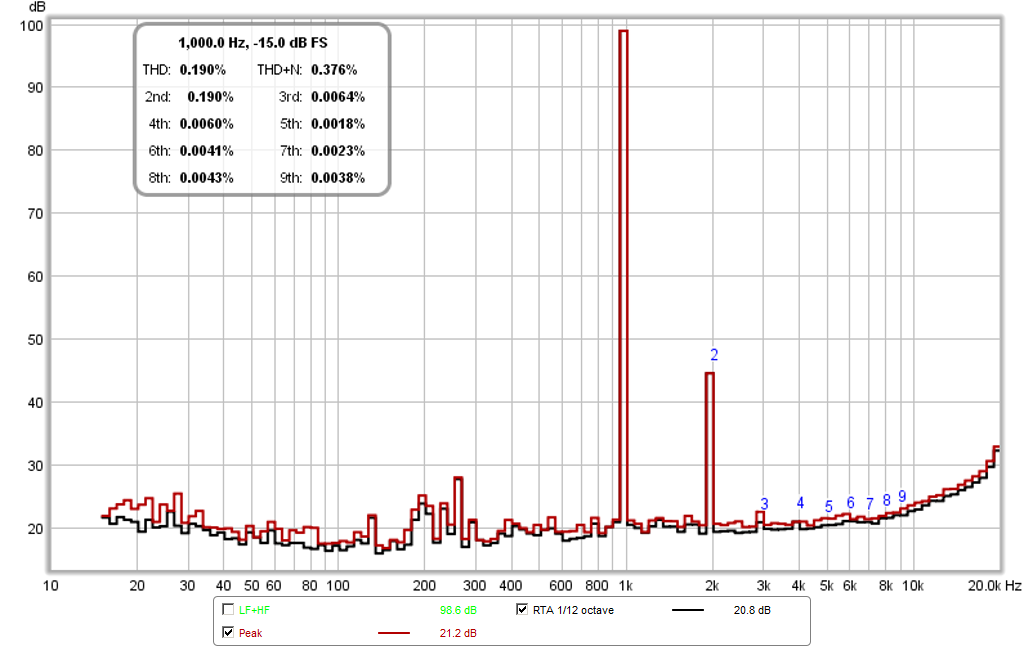
Here is what I was able to do with a little 2.5in SB65WBAC25-4.
http://www.diyaudio.com/forums/full...l-range-tractrix-synergy-122.html#post4554591
Here is HD plot of 10F in the Trynergy at 1m and 100dB (mostly 2nd order and 3rd is tiny):

Last edited:
Thanks xrk! Interesting. For now the plan is to work with what I have, a HF144 CD. I am going to make the throat adapter removable, so a different adapter could easily be made to fit something else. I am totally down to try it.
Manufacturer's response curve for the HF144 below
EDIT: just looked at the specs of the Scanspeak 10F/8424, looks to be nice and tiny depth-wise. Would be an easy fit dimensionally. Heckuva lot cheaper than a 3" diaphragm CD.
Manufacturer's response curve for the HF144 below
EDIT: just looked at the specs of the Scanspeak 10F/8424, looks to be nice and tiny depth-wise. Would be an easy fit dimensionally. Heckuva lot cheaper than a 3" diaphragm CD.
Attachments
Last edited:
How well can these cone mid-tweets work at PA levels? Could it comfortably reach the same system SPL levels as with the CD?That tweeter aperture looks to be the perfect size for a 3.5in driver like a Scanspeak 10F/8424. Lower distortion and still 102dB with horn gain - a perfect match for dual 10CL65's. Plus you can cross over at 800Hz. Just a thought - even Weltersys has done this with a $10 TC9FD and agrees it sounds cleaner than a CD.
Interested because it could have some significant implications if you could cut the driver cost on a synergy design similar to this.
Coincidentally, I picked up some OEM Mackie drivers off Craigslist for $15 each that look veeeery similar to Typhany FSL-1020R02-08, which in turn has very similar specs to the B&C drivers used here. Could make for a very amusingly low cost build.
Last edited:
Posting some progress
Phase plug is mounted (not sealed/glued yet)
Cut the side cleats and glued them
Installed the sides first (horn was just ever so slightly out of true, this will let me use the sides to true it up when the rest of the box is put together)
Phase plug is mounted (not sealed/glued yet)
Cut the side cleats and glued them
Installed the sides first (horn was just ever so slightly out of true, this will let me use the sides to true it up when the rest of the box is put together)
Attachments
Thanks xrk! Interesting. For now the plan is to work with what I have, a HF144 CD. I am going to make the throat adapter removable, so a different adapter could easily be made to fit something else. I am totally down to try it.
Manufacturer's response curve for the HF144 below
EDIT: just looked at the specs of the Scanspeak 10F/8424, looks to be nice and tiny depth-wise. Would be an easy fit dimensionally. Heckuva lot cheaper than a 3" diaphragm CD.
That is a nice driver - wish I had one. It's actually designed for the LTH142 waveguide that I used for the bookshelf point source horn, which is now running the SB65WBAC25-4.
The 10F won't be able to generate pro level SPL's of course but is a great choice for HiFi or HT use. What it does make though will sound very clean relative to a compression driver.
Good idea to make throat adapters and easy to try at later time. You may just like what you hear.
I like the anvil!
Mine is made from main line railway track.
And I have used it in almost the same way!
Keep up the good work.
Mine is made from main line railway track.
And I have used it in almost the same way!
Keep up the good work.
If all you saw was 4-5mm peak to peak there was more than 6 dB of peak headroom left in the 10"s.A side thought in regards to the 10" driver:
The channel has been routed to permit movement to xmax, but theoretically the driver can move further than that, so there is a potential for it to crash into the horn wall piece at some point.
Peering into the holes, the most amount of movement I eyeballed was about 4-5mm peak to peak at full volume (full volume being limiters starting to nudge on the CD) So it seems there is no need to actually move right up to xmax.
The channel is routed to avoid crashing at Xlim, not Xmax. The driver will exceed Xmax at well below full power if driven below Fb, which could happen if using the cabinet in a "full range" application- people have been known to load in the wrong presets ;^).
Originally Posted by xrk971
That tweeter aperture looks to be the perfect size for a 3.5in driver like a Scanspeak 10F/8424. Lower distortion and still 102dB with horn gain - a perfect match for dual 10CL65's. Plus you can cross over at 800Hz. Just a thought - even Weltersys has done this with a $10 TC9FD and agrees it sounds cleaner than a CD.
The HF beaming of the small cone drivers limits the horizontal dispersion on a conical horn to around 45 degrees, rather than the 90 degrees the compression driver achieves.
Art
That tweeter aperture looks to be the perfect size for a 3.5in driver like a Scanspeak 10F/8424. Lower distortion and still 102dB with horn gain - a perfect match for dual 10CL65's. Plus you can cross over at 800Hz. Just a thought - even Weltersys has done this with a $10 TC9FD and agrees it sounds cleaner than a CD.
Because of the much lower sensitivity a cone driver used for HF would limit the output to around 6-10 dB less- I'm using eight TC9FD-18-08 on 13 degree Maltese horns as center fill (4 per side) below the SynTripP cabinets.How well can these cone mid-tweets work at PA levels? Could it comfortably reach the same system SPL levels as with the CD?
Interested because it could have some significant implications if you could cut the driver cost on a synergy design similar to this.
The HF beaming of the small cone drivers limits the horizontal dispersion on a conical horn to around 45 degrees, rather than the 90 degrees the compression driver achieves.
Art
thunk, Fin was just telling me about somebody who recognized him from this thread while he was at a friend's place.. Is that you, maybe?
I can't wait to hear them. All of these experience reviews are getting me all giddy inside!!
Need a lathe!!
Don't think so, I have know fin for years. I had the pleasure of listening to the SynTripP outdoors where we could play with the eq for a few hours. Sitting about 100 metres back with a beer was a real moment. At one point we started getting close to flat response and they went from ok to solid gold! 😀 Have fun
The light at the end of the tunnel is still a ways away, but it is discernible. The box went together perfectly, and everything is square
Printing the second phase plug, then onto the throat adapter
Cannot wait for first sound. My roommates are stoked, too!
Printing the second phase plug, then onto the throat adapter
Cannot wait for first sound. My roommates are stoked, too!
Attachments
My recommendation for awesome first sound experience.
Go outdoors somewhere. Away from noise and reflections if you can.
Time align the CD and Mids.
EQ flat with a measurement mic.
Put on some well recorded vocal stuff. Things your brain has references to.
Go back 25 feet and sit on a rug with some beer/cider for half an hour getting accustomed to the point source nature if it.
After a while, go for a walk around. Listen to what this thing can do from a distance. It's quite surreal.
Go outdoors somewhere. Away from noise and reflections if you can.
Time align the CD and Mids.
EQ flat with a measurement mic.
Put on some well recorded vocal stuff. Things your brain has references to.
Go back 25 feet and sit on a rug with some beer/cider for half an hour getting accustomed to the point source nature if it.
After a while, go for a walk around. Listen to what this thing can do from a distance. It's quite surreal.
JG,
Nice model of adapter. You might consider making it longer so that the expansion from 1.4in dia round to rectangle can be more gradual. I am thinking about 3x - 4x longer. My experience with a throat adapter on the xBush point source horn is that a gradual expansion made all the difference and reduced the cancellation dips corresponding to ten throat dia.
Nice model of adapter. You might consider making it longer so that the expansion from 1.4in dia round to rectangle can be more gradual. I am thinking about 3x - 4x longer. My experience with a throat adapter on the xBush point source horn is that a gradual expansion made all the difference and reduced the cancellation dips corresponding to ten throat dia.
- Home
- Loudspeakers
- Multi-Way
- SynTripP: 2-way 2-part Virtual Single Point Source Horn
